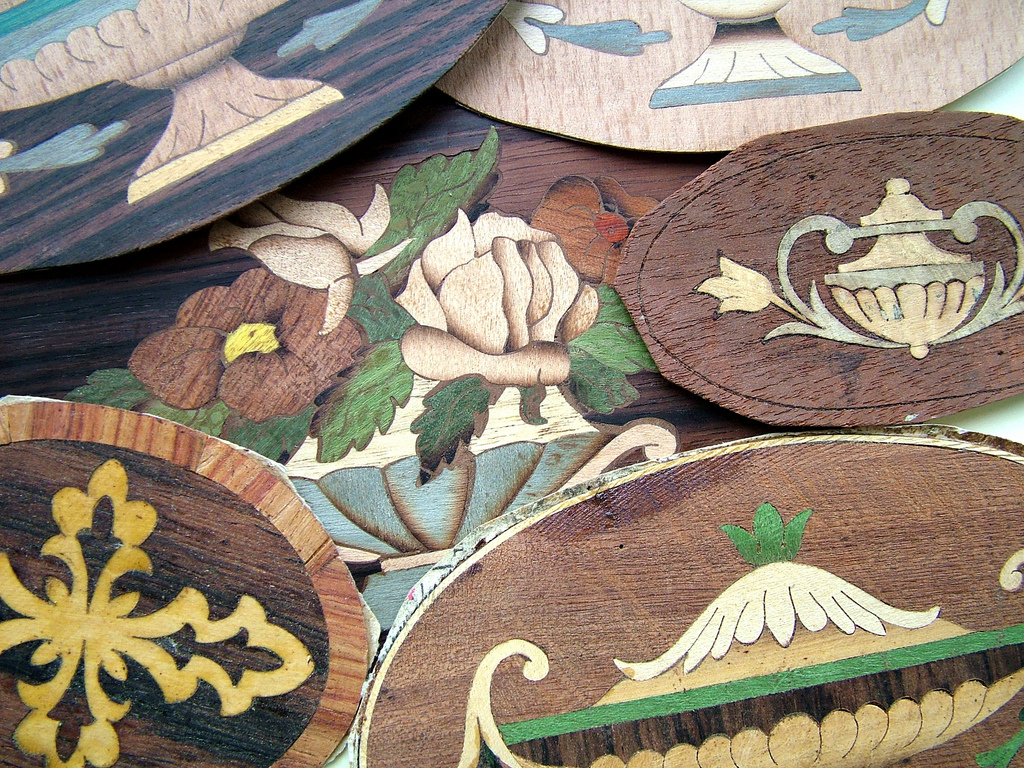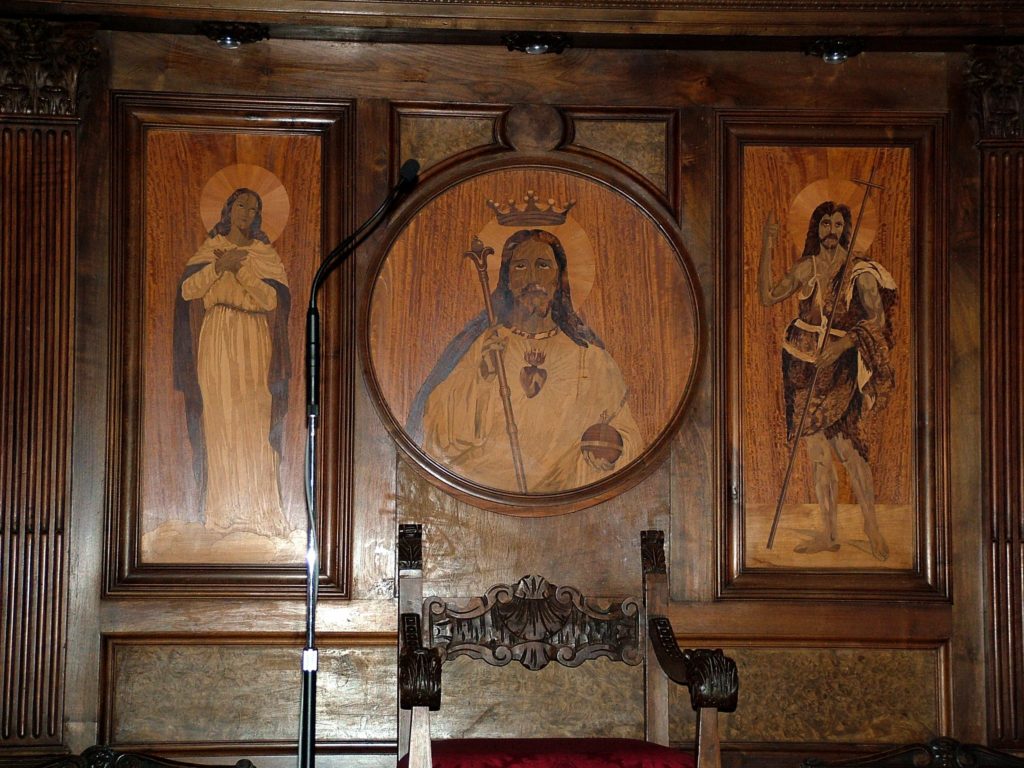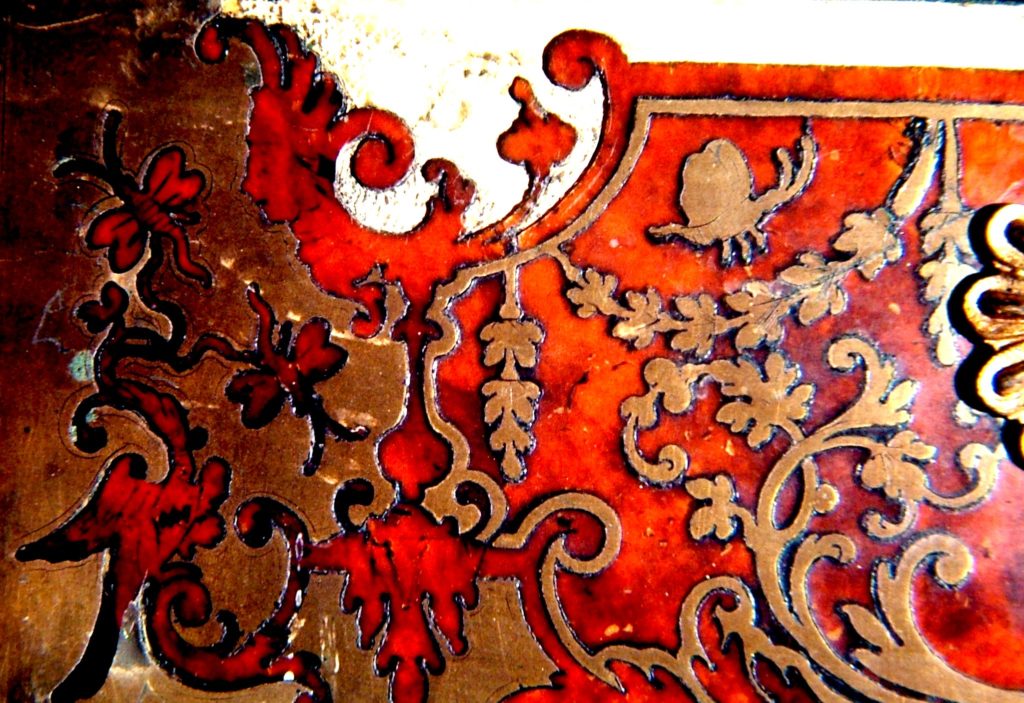
The earliest evidence that I am aware of for marquetry/inlay is a remarkable casket from the city or UR, in Mesopotamia dated c2600 BC. Much of the work is cut from ivory and set in bitumen and is a pictorial representation of a mixture of royal and daily life. Not until the European renaissance do we again encounter pictorial decoration using contrasting veneers in the form of intarsia. This inlay technique was originally centred in the Italian city of Sienna in the 11th century and much used to decorate church furniture and panels.
Homer was the first, in 700 BC, to describe the ornamentation of furniture with prized materials. Ulysses tells Penelope about the bridal bed that he made:
” Beginning from the bed post, I wrought at the bed head till I had finished it, and made it fair with inlaid work of gold, silver and ivory”.
Homer, In book 23 of the Odyssey
The early use of wood veneers for decorative purposes dates to ancient Egypt. The Pharaohs were familiar with chairs and chests that incorporated thinly sliced sections of contrasting woods and semi precious materials assembled in geometric patterns.
Decorated casket recovered from the royal graves at Ur in Mesopotamia. The ivory bone and stone inlay is embedded in bitumen and was created C2600 BC. From the British museum.

Marquetry and inlay are often confused. All marquetry can be described as inlay because each individual component can be said to be inlaid into each other. Conversely, true inlay can never be defined as marquetry as it is composed of segments in which a space is first chiselled into the solid ground to be then filled with a piece cut to fit. Intarsia panels come into this category.
Roman marquetry
” The wood of beech is easily worked – cut into thin layers of veneers, it is very flexible, but is only used for the construction of boxes and desks. The wood of the holme oak is cut into veneers of remarkable thinness, the colour of which is far from unsightly. The best woods for cutting into layers are the terebinth, varieties of maple, box, palm, holly, root of the elder and poplar. In order to make a single tree sell many times over, laminae of veneer have been devised; then after all this, man must go and seek his materials in the sea as well! For this purpose he has learned to cut tortoise (turtle) shell into sections; and of late, in the reign of Nero, there was a monstrous invention devised of destroying its natural appearance with paint, making it sell at a still higher price by successful imitation of wood. “
The Roman naturalist Pliny the Elder, writing in the first century AD, in book 16
So here we have the Romans nearly two thousand years ago, not only producing economically inspired veneered furniture, but also introducing imitation wood effects that out do the real thing.
Sorrento ware
Today, the Italian town of Sorrento, for the time being, is the centre of a thriving marquetry industry. I say at the time being because on a recent visit and talking to some of those involved, it appears that it is becoming more difficult to engage the young’s interest in following this traditional craft. Since the early 19th century highly skilled Sorrento practitioners have created a vast range of inlayed and marquetry work, it has even acquired its own descriptive title: Sorrento ware. This can range from huge marquetry wall panels like those in Sorrento Cathedral to delicately stunning musical boxes.

History of marquetry in England and France
Until the last quarter of the 17th century the use of veneers in England was one of restraint, usually restricted to simple inlayed decoration on chests and dressers. All this was to change with the arrival to England of William of Orange to rule jointly with his wife Mary in 1689. Marquetry as a complete art form was introduced into England by the artisans who accompanied William and his court to London and made an immediate impact on chest/carcase type furniture and long case clocks in particular.
The zenith of marquetry was in the late 17th and early 18th century France, where the craft reached the status of high art through generous royal patronage. André Charles Boulle was in the vanguard of the French movement. By 1672 he was ensconced in the royal workshops of Louis XIV. Boulle supplied much furniture to the palace of Versailles.
His name lives on today in ‘Boulle work’, intricate marquetry that includes the use of silver, brass, pewter, tortoise shell and ebony (see photo, right). Boulle’s technique was similar to that used all over Europe at the time, known as ‘cut and counter cut’. A packet was made up of, say, ebony veneer and sheet brass in equal amounts and was then cut using a marquetry horse and fret saw (later to become united and referred to as a donkey, see photo below) The packets were then separated, and the individual components reassembled to produce contrasting panels, e.g.; brass inlaid into ebony and ebony inlaid into brass, both panels would have been used but on different articles.
Boulle marquetry being restored, French 18th Century. Boulle work usually incorporates turtle shell and any of the following; brass, pewter, silver and occasionally other metals. Much of this work has suffered from the loss of surface material due to poor adhesion and damp.

The history of marquetry is a long and complex one and I have only just scratched the surface in telling this tale. It is a journey I have enjoyed and wish you all a similarly fruitful trek through your chosen walk with wood.
More marquetry articles
Read my other marquetry articles: Marquetry and Me and Khokhloma Ware: Folk art for the masses. For more photos and illustrations from the history of marquetry please visit my Marquetry Gallery.

Glossary of marquetry terms
Lengths of decorative strips made up of contrasting woods cut to various profiles and supplied in a variety of widths in one metre lengths. Used to frame or outline veneered panels. Producing bandings is the job of a specialist. (See cross-banding)
Marquetry consisting of a combination of materials e.g. chosen from pewter, brass, silver, tortoise (turtle) shell, ebony etc. French cabinetmaker André-Charles Boulle 1642-1732 perfected this art.
Using consecutive leaves of veneer turned over, as in opening a book.
Applying a backing tape to the reverse side of a veneer packet whilst cutting is in progress to give support to elements that may otherwise break-out from the back.
Wide strip of straight grained veneer applied at right-angles to the main panel, usually cut and applied by the veneer matcher. Used to frame the outer edge of veneered panels, often in conjunction with decorative bandings.
Method of cutting marquetry using a fretsaw, usually via the marquetry donkey or horse. A packet of equal numbers of (for instance) light and dark veneers is fret-cut, the contents then dissembled and rearranged into a design of contrasting veneers.
Using straight grained veneer to produce a chevron effect.
True inlay is where individual veneer sections are inserted into a solid wood ground or inlaid.
Early technique whereby thick saw-cut veneers are individually inlaid into a solid wood ground, developed during the Italian renaissance. The term is used today in Italy to describe marquetry. It is also used today to describe designs (usually pictorial) made up of shaped solid wood permanently assembled jig-saw fashion.
Veneer produced on a large machine where the solid log is sliced with a large knife, typically .7mm thick.
Term used to describe a complete log that has been converted into veneers where the veneer leaves are tied in bundles of 32 and remain in the order in which they were cut until ready for use.
The art of creating decorative designs using contrasting veneers.
Development of the marquetry horse dating to c1780, now incorporating a fixed arm to support the fretsaw frame and allowing more accurate work to be achieved.
Foot-operated pair of jaws incorporating a seat allowing the operator to fret-cut packets of veneers.
Method of cutting marquetry using a fretsaw, usually via the marquetry donkey. This is the most skillful of techniques; it requires a number packets of veneers to be made-up representing all the different colours contained in the design. Duplicates of the paper design are printed to allow a section of each design element to be cut out and applied to the appropriate packet. Each of the adjacent edges of the design is then cut, one edge on the line of the design, the other just off the line, thus ensuring a perfect fit!
Usually small self-contained marquetry elements of geometric outline, often containing a classical motif within, e.g. a shell, flowers, urn etc.
Sandwich of veneers held together using fine veneer pins and paper tape.
A veneered panel made up of four consecutive veneers each aligned as in book matching but creating a panel consisting of a leaf of veneer at all four corners.
Veneer produced on a large machine where the solid log is rotated against a large stationary knife, pencil sharpener fashion.
Veneer produced by sawing, originally by hand and subsequently sliced using circular saws. Saw-cut veneer is thicker than knife/rotary cut.
One metre lengths of small square section solid wood often used in conjunction with cross banding to provide a thin line of contrasting colour. Boxwood and ebony are the most commonly used woods.
Very fine and delicately scrolled marquetry popular at the beginning of the 18th century; probably the most difficult of all marquetry forms to execute.
Dipping appropriate elements of a marquetry design into hot sand to scorch it, so achieving a three dimensional effect.
A very thin sheet of wood
Creating a decorative panel consisting of veneers held together using gummed paper tape prior to ‘pressing’ onto a board or ‘ground-work’. The completed veneer sheet is referred to as a ‘lay-on’.
Not really a hammer but a short handled tool with a head fixed at right-angles, used for squeezing out excess glue whilst hand-veneering.
Marquetry created using a ‘waster’ upon which the design is applied and from which each element of the design is individually replaced with a contrasting veneer.
